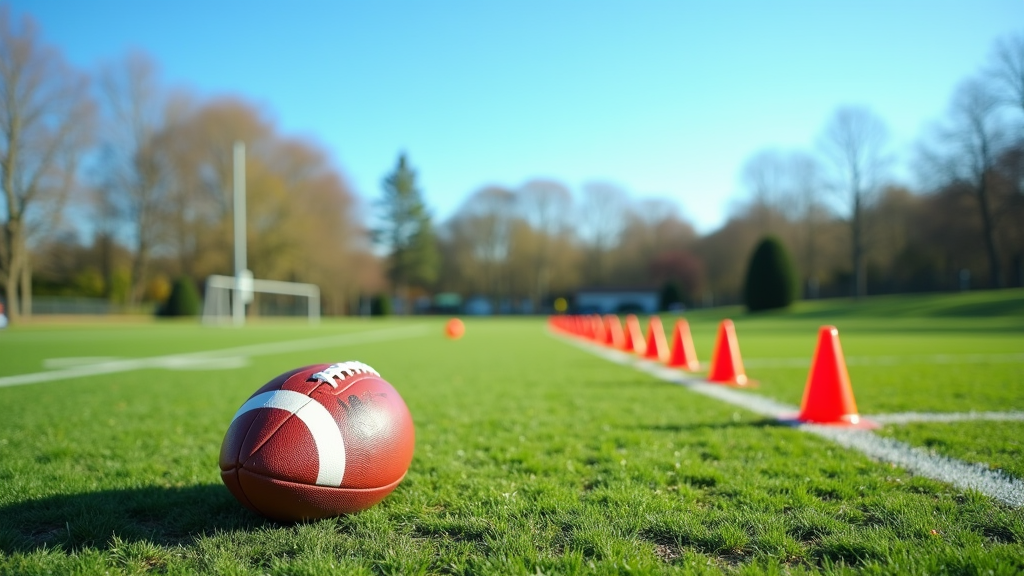Football training doesn’t always require fancy equipment or a gym. I’ve built plenty of effective workouts for football right at home or on the field, using just bodyweight and a little bit of space. If you’re looking to improve your speed, strength, and stamina for the game—even if you don’t have gear—this guide will give you everything you need to start strong. I’m breaking down the basics, the workouts, some technique tips, and even the best ways to give a boost to your football performance using nothing but your own body.

Why a No Equipment Football Workout Plan Works
Most football movements use explosive strength, agility, and endurance. These can all be built using just bodyweight. No equipment training lets you focus on natural movement patterns like running, jumping, pushing, and core work—the same muscles you use on the field. That means improved game fitness and a quicker first step, without needing a weight room. You can train at home, in your backyard, at a local park, or even in your living room.
Learning to train this way not only builds strength but also helps with balance, stability, and mobility. These are super important for staying healthy during long football seasons and for keeping your reactions sharp when the ball is in play.
Bodyweight workouts have actually been used by some of the most skilled athletes around. A 2022 study in the Journal of Strength and Conditioning Research showed that bodyweight training can build both explosive strength and endurance, which is just what you want as a football player.
Setting Up Your No Equipment Football Workout Space
Before starting, it’s helpful to have about a 10×10 foot clear space or an open yard for sprints and agility work. If you’re working inside, move furniture if needed to create some room. Have a water bottle for hydration, a towel for sweat, and a timer on your phone.
To minimize injury, make sure you have a safe surface—grass, turf, or even carpet is fine. Stay away from anything slippery. Doing a quick warm-up and cooldown before and after every session keeps your muscles feeling good and lowers the risk of soreness or injuries.
If you want to keep yourself extra motivated, write down your goals before each session or share them with a friend who also enjoys football. That way, training becomes something you look forward to and track over time.
Football Warm Up: Get Your Body Ready to Move
Jumping right into sprints or jumps without a proper warm up is a fast track to muscle pulls. Warming up gets the blood flowing and switches your body into “game mode.” Here’s a basic routine that works well before every bodyweight football session:
- High Knees (30 seconds): Great for getting the heart rate up.
- Butt Kicks (30 seconds): Loosens up hamstrings and preps the knees.
- Lateral Shuffles (30 seconds): Perfect for moving side to side, just like on defense.
- Arm Circles (30 seconds): Gets shoulders loose for throwing and blocking.
- Dynamic Lunges (10 reps each leg): Builds mobility and fires up the glutes and quads.
Use short bursts of each movement to gradually elevate your heart rate. In about four or five minutes, you’ll feel ready to go.
The Core No Equipment Football Workout Plan
The foundation of a quality football workout covers speed, agility, total body strength, and core power. This bodyweight plan covers all those basics using simple moves that anyone can pick up—from beginners to advanced players. Try running through this routine three to four times a week, leaving at least one day for rest in between.
Bodyweight Circuit (Repeat 3-4 Times)
- Burpees (12 reps): Builds total body explosiveness and cardio. Drop down, chest to the ground, then spring up and jump tall.
- Pushups (15-20 reps): Strengthens chest, triceps, and shoulders—the same muscles you use to hold off defenders or push through tackles.
- Squat Jumps (12 reps): Works on lower body drive and vertical jump, vital for sprint starts and tackles.
- Plank Shoulder Taps (20 reps total): Trains your core to stay strong during movement. Keep your hips steady for more challenge.
- Reverse Lunges (10 reps each leg): Balances leg development and prepares you for quick directional changes.
After you finish the circuit, rest for 1-2 minutes, then repeat. Try for three to four rounds total. As you get stronger, boost your reps or challenge yourself by cutting down rest time.
Speed and Agility Drills with No Equipment
Speed and agility matter just as much as strength in football. These drills help you build explosive quickness for chasing down passes or dodging tackles. All you need is a patch of grass or any safe space.
- Sprint Intervals: Mark two points about 15-20 yards apart (use cones, rocks, or even your towel). Sprint to one end, jog back, repeat for 5-8 rounds. Pause for a minute after every two sprints.
- Shuttle Runs: Place three markers—start line, 5 yards out, 10 yards out. Run to the first, back, run to the second, and back. Do two sets of 5 reps each.
- Lateral Bounds: Hop side to side over an imaginary line. Go for 30 seconds, focusing on quick changes.
- Quick Feet “Ali Shuffle”: Stand on an imaginary line, step one foot forward and the other foot back, switching quickly for 30 seconds. Great for footwork and balance.
You’ll feel your pulse ramp up on these. Make sure you rest enough to keep your speed high for each round so you get the full benefit.
Technique Focus: Drills to Give a Boost to Football Skills
Practicing core football movements without equipment can help you keep your technique sharp. Here are a few examples I use to work on football-specific skills even off the field:
- Shadow Blocking: Set up a low stance and practice short, powerful push movements forward and sideways. Think about keeping your hands up and moving your feet quickly, just like blocking in a real game.
- Mirror Defense: Imagine following an opposing player. Sidestep, react, keep your hips low. This is especially effective for linebackers and corners.
- Air Cuts: Plant one foot and change direction quickly, like moving away from a tackler. Practice to each side, staying balanced and powerful.
- Jump and Land: Simulate catching a ball. Jump straight up, then land softly on both feet, ready to move again.
Adding these drills to your weekly plan helps turn strength and speed into useful football moves. If you want even more specific drills for your position, check out highlight reels from top athletes to get inspiration and add some to your own training.
Staying Motivated Without Equipment
Not having access to weights or training gear can feel limiting, but sticking to a consistent, varied plan like this helps you stay locked in. Setting small personal goals—like extra reps, faster sprints, or holding your plank longer—makes your progress obvious. Keeping a workout log or teaming up with a friend (in person or online) can make training more fun and encourage each other.
Switching up your routine every few weeks is smart too. Try different orderings, add rest-pause sets, or challenge yourself with new personal bests. Progress is always possible when you push yourself just a little beyond your comfort level.
Practical Tips for a Safer, More Effective Workout
- Warm Up and Cool Down: Never skip these. Preps your body and helps with soreness.
- Focus on Form Over Speed: Especially with jumps or sprints. Doing proper reps is better than rushing through them.
- Stay Hydrated: Football drills can get intense, especially outside. Water is your best friend for recovery.
- Mix in Variety: Switch your rep counts or try tempo tweaks (like slow lowering on pushups) to keep muscles working hard.
Sticking to these tips helps you stay injury-free and makes the most of your no equipment workout plan.
Frequently Asked Questions
Here are a few common questions people ask about no equipment football training:
Question: Can I really get stronger for football just using bodyweight?
Answer: Absolutely. Many football basics—like sprinting, jumping, push-offs—are all based on bodyweight moves. Focus on progression (more reps, tougher variations) for best results.
Question: How often should I do these no equipment workouts?
Answer: Three to four days per week works for most people. Make sure you have at least one full recovery day each week.
Question: Do I need to be fit already to start?
Answer: Not at all. Begin with easier versions (like knee pushups or stationary lunges) and go from there. It’s all about building your foundation consistently.
Game On: Keep Pushing, Keep Improving
No equipment football workouts help you become a better player by boosting your natural speed, agility, and strength. The ability to train anywhere, anytime gives you serious flexibility—whether you’re prepping for the season, keeping up your skills in the offseason, or just looking for ways to level up your game without fancy stuff. (And if you ever reward yourself with a post-workout snack, you’re not alone!)
Bringing your own energy and consistency is the key for results. Every rep and every sprint help you become quicker, stronger, and more game-ready. Whenever motivation dips, just remember: simple, regular effort can take you a long way in football. Stay consistent, celebrate every bit of progress, and keep raising your standards one workout at a time!
